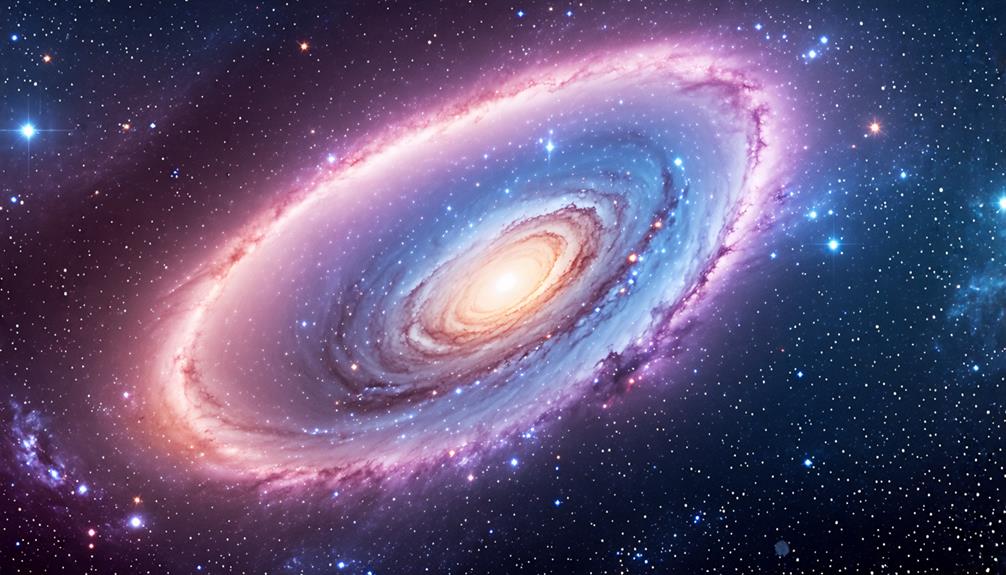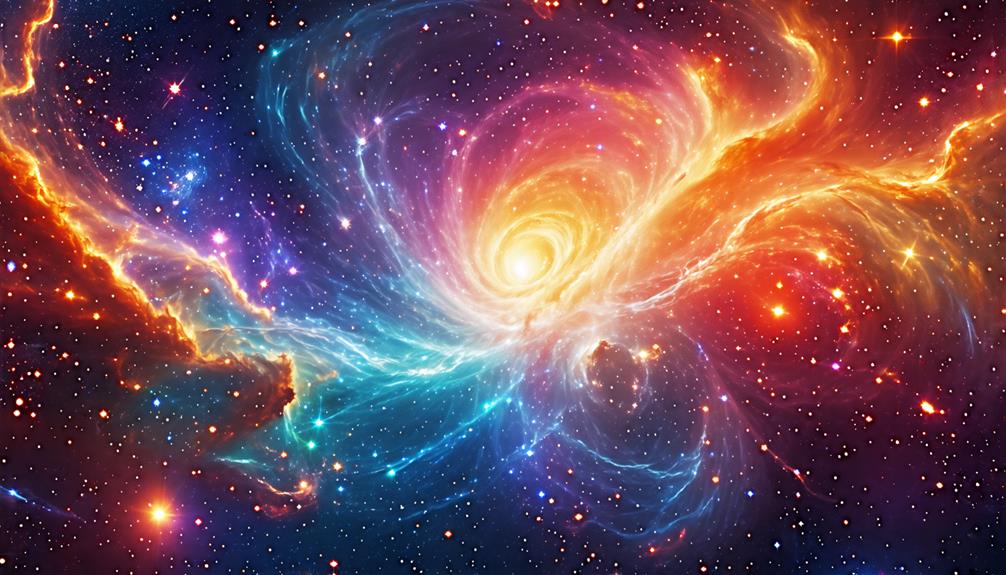Fast Radio Bursts Explained: the Mysterious Signals From Distant Galaxies
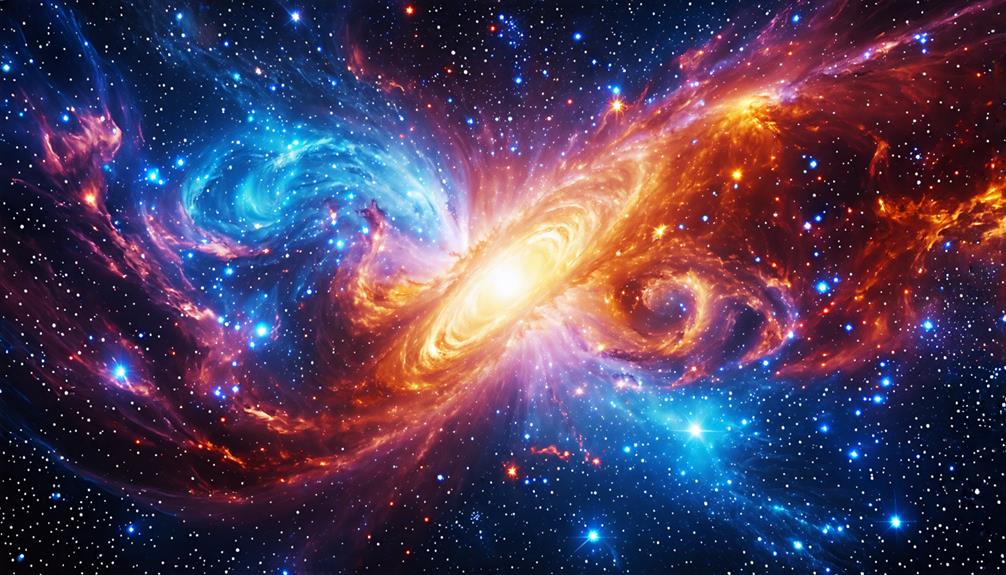
Fast Radio Bursts (FRBs) are brief, yet incredibly powerful, radio signals originating from distant galaxies. First identified in 2007, they release more energy in a few milliseconds than the Sun does in an entire day. While most FRBs are linked to magnetars, the exact mechanisms behind their origins remain a subject of active research and debate. Understanding these enigmatic signals could provide profound insights into the universe's structure and the extreme conditions in which they arise. What implications could these transient events have for our understanding of astrophysics?
Understanding Fast Radio Bursts
Fast Radio Bursts (FRBs) are extremely brief yet immensely powerful emissions of radio waves, capable of releasing as much energy in milliseconds as the Sun does over several days. Originating from distant galaxies, these bursts have garnered significant attention in the field of astronomy. Since their initial detection, over 1,000 FRBs have been documented, with scientists estimating that around 10,000 occur daily, although only a small fraction are detectable from Earth.
The predominant hypothesis regarding the origin of FRBs points to magnetars, which are highly magnetic neutron stars. Evidence indicates that certain FRBs are directly associated with magnetar activity. FRBs are classified into two main types: repeating and non-repeating. Repeating FRBs suggest a long-lived source, while non-repeating bursts are likely tied to singular cosmic events, such as neutron star mergers. Each new FRB detection provides valuable insights into these astronomical phenomena, advancing our understanding of the universe. Further investigation reveals the complex connections between these bursts and the fundamental forces that shape our cosmos.
Discovery and Historical Context
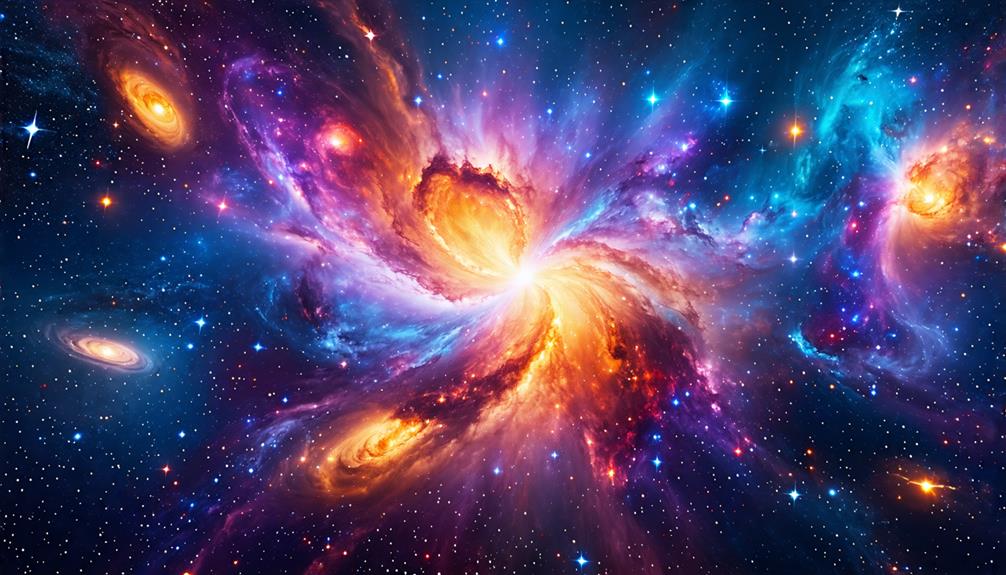
The journey to understanding Fast Radio Bursts (FRBs) began in 2001 with the detection of the Lorimer burst, marking the start of a new era in astrophysical research. Although initially identified in 2007, this first FRB ignited significant interest and investigation into these mysterious radio signals. The Keane burst, discovered in 2011 during a pulsar survey, further expanded the spectrum of known FRBs and suggested a variety of potential sources.
A pivotal moment occurred in 2012 with the discovery of the first repeating FRB, FRB 121102, which indicated that some sources could emit multiple bursts over time, challenging existing theories on their origins. The record for the most distant known FRB was set in 2022 with the detection of FRB 20220610A, originating from approximately 13 billion light-years away.
In 2020, the detection of FRB 200428, which was traced back to a magnetar within our Milky Way, revealed that FRBs could arise from diverse cosmic environments. This ongoing history of discovery continues to drive interest and research in the field, setting the stage for future advancements in astrophysics.
Characteristics and Types of FRBs
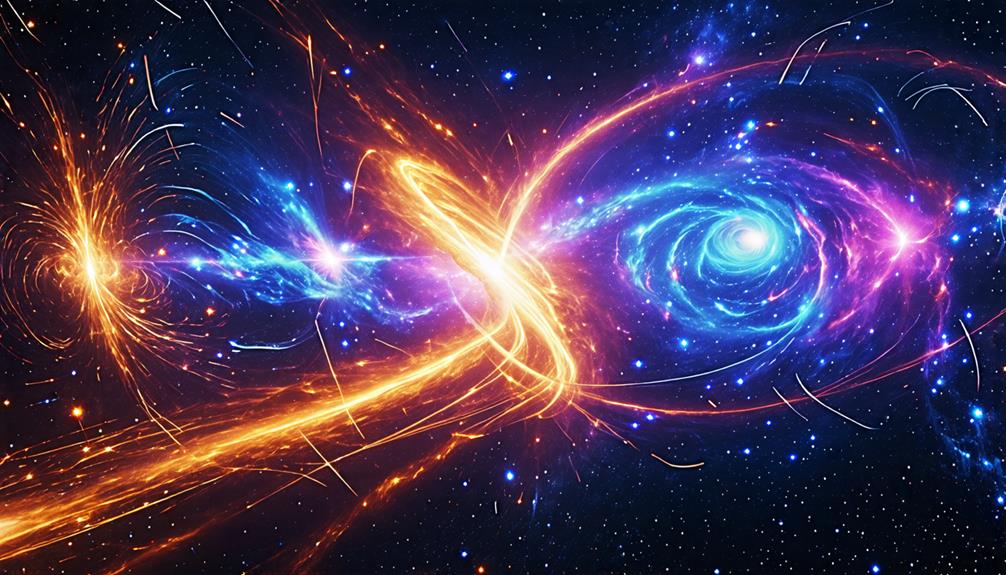
Fast Radio Bursts (FRBs) exhibit a variety of characteristics that intrigue scientists. Primarily, FRBs are categorized into repeating and non-repeating events. These distinctions suggest diverse mechanisms for energy release. Understanding these differences can provide valuable insights into the origins and nature of these enigmatic cosmic phenomena.
Types of FRBs
Fast Radio Bursts (FRBs) are primarily categorized into two types: repeating bursts and non-repeating bursts. Repeating bursts emit signals multiple times, whereas non-repeating bursts occur as isolated events. As of April 2023, only about 18 of over 1,000 documented FRBs have been identified as repeaters, highlighting the rarity of repeating FRBs among these powerful signals from distant galaxies.
Here's a concise comparison of the two types:
| Type | Characteristics |
|---|---|
| Repeating FRBs | Emit multiple signals over time, e.g., FRB 121102 |
| Non-repeating FRBs | Occur as single, isolated transmissions |
Both types of FRBs exhibit immense energy, often releasing as much energy in milliseconds as the Sun emits in a day. Although an estimated 10,000 FRBs may occur daily, most are too weak to be detected by current technology when they reach Earth. Understanding these classifications aids astronomers in pinpointing the sources of these mysterious signals, offering insights into the universe's deeper secrets.
Energy Release Mechanisms
Understanding the energy release mechanisms behind Fast Radio Bursts (FRBs) is key to unraveling how these extraordinary phenomena generate immense power in mere milliseconds. FRBs can produce energy equivalent to what the Sun emits over several years within such a short duration. The leading hypothesis attributes these bursts primarily to magnetars—highly magnetized neutron stars experiencing violent surface activity. This intense energy release often results from the collapse of massive stars or interactions with black holes.
Many FRBs are located in regions of active star formation, particularly within compact galaxy groups, which likely provide the necessary conditions for their generation. For instance, the repeating FRB 121102 suggests a connection to specific astrophysical processes occurring in star-rich areas. Observations of the most distant FRB, 20220610A, indicate that bursts of radio waves can arise in diverse galactic environments, broadening our understanding of these phenomena. As researchers continue to investigate the characteristics of FRBs, the focus on energy release mechanisms will shed light on the complex interactions within our universe.
Potential Sources of FRBs

Recent findings suggest that magnetars, with their intense magnetic fields and explosive behavior, are key players in the generation of Fast Radio Bursts (FRBs). These compact objects, a type of neutron star, exhibit extreme energy releases that align with the origins of fast radio signals. The connection between magnetars and FRBs became particularly evident with the detection of FRB 200428, linked to magnetar SGR 1935+2154.
Researchers are investigating several potential sources of FRBs, including:
- Colliding neutron star binaries
- Merging white dwarfs
- Blitzars, or collapsing neutron stars
- Repeating FRBs, often associated with persistent magnetar activity
This diversity in potential sources suggests that the mechanisms behind these mysterious radio bursts might vary significantly. By studying the energy and behavior of different compact objects, researchers gain insights into the nature of these enigmatic signals. As ongoing research delves deeper into the roles of magnetars and other potential sources, our understanding of these puzzling phenomena continues to evolve.
Observational Techniques and Technology
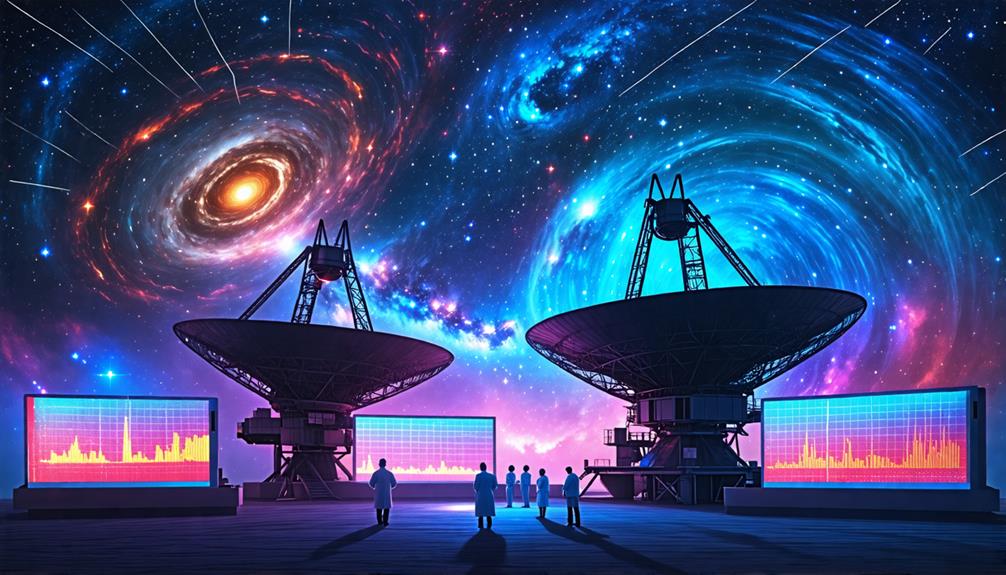
To uncover the mysteries of Fast Radio Bursts (FRBs), astronomers rely on advanced observational techniques and cutting-edge technology that enhance their ability to detect and analyze these fleeting signals. Radio telescopes like the Australian Square Kilometre Array Pathfinder (ASKAP) and the Very Large Telescope (VLT) are crucial for spotting and tracking FRB signals. Since the first FRB was detected in 2007, improved sensitivity in detection methods has led to the discovery of hundreds of these enigmatic bursts.
The Hubble Space Telescope has been instrumental in imaging the environments around FRBs, helping astronomers identify their origins within compact galaxies and other cosmic structures. Coordinated multi-wavelength observations, including data from the NICER and NuSTAR telescopes, provide unprecedented insights into the behavior of magnetars associated with FRBs and their magnetic fields.
As technology continues to evolve, future research will employ even more advanced observational techniques to deepen our understanding of FRB phenomena and their interactions with cosmic material. This ongoing work could unveil new insights about the universe, transforming our knowledge of these fascinating signals from distant galaxies.
Implications for Astrophysics and Cosmology
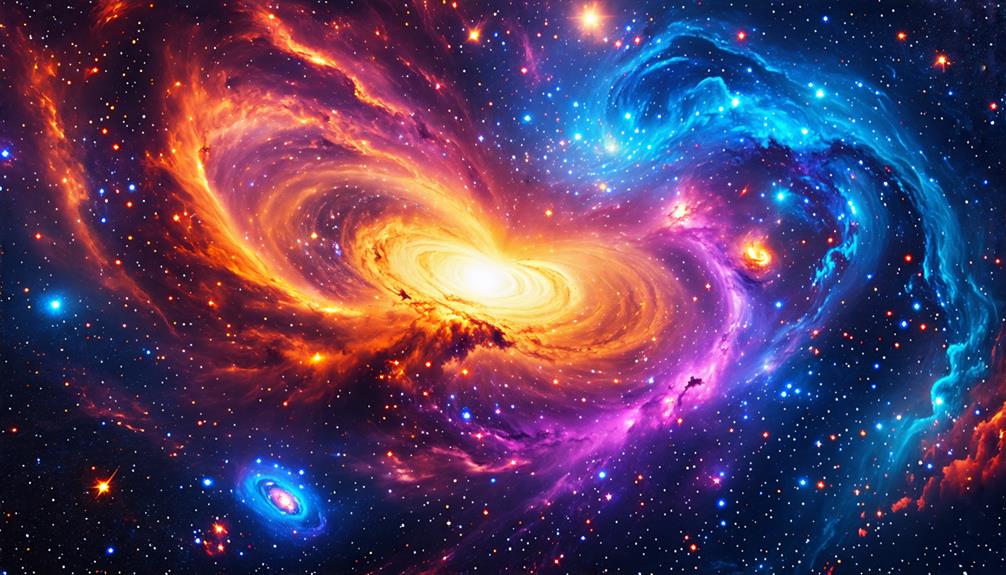
Fast Radio Bursts (FRBs) are not only enigmatic but also hold significant implications for astrophysics and cosmology, unveiling the intricate mechanisms that govern our universe. These transient signals offer a distinctive perspective on high-energy processes spanning various cosmic environments.
Key implications of FRBs for our understanding of the universe include:
- Energy Insights: FRBs can emit energy comparable to the Sun's total output over days in just milliseconds, illuminating extreme astrophysical processes.
- Diverse Origins: They are traced back to a variety of galactic structures, including dwarf galaxies, enhancing our understanding of different cosmic environments.
- Mapping Cosmic Structures: FRB studies aid in mapping interstellar gas clouds and their interactions, crucial for comprehending cosmic evolution.
- Connection to Magnetars: Exploring potential links between FRBs and magnetars could elucidate the mechanisms behind extreme astronomical phenomena.
Conclusion
Exploring Fast Radio Bursts (FRBs) unveils a fascinating dimension of our universe. These brief yet powerful signals challenge our understanding of astrophysics and the cosmic landscape. As research progresses, new discoveries are likely to reshape our knowledge of these extreme phenomena. Whether FRBs are linked to magnetars or other mysterious sources, they highlight the universe's complexity and our ongoing quest to unravel its secrets. Keep observing the skies; there is much more to learn!

